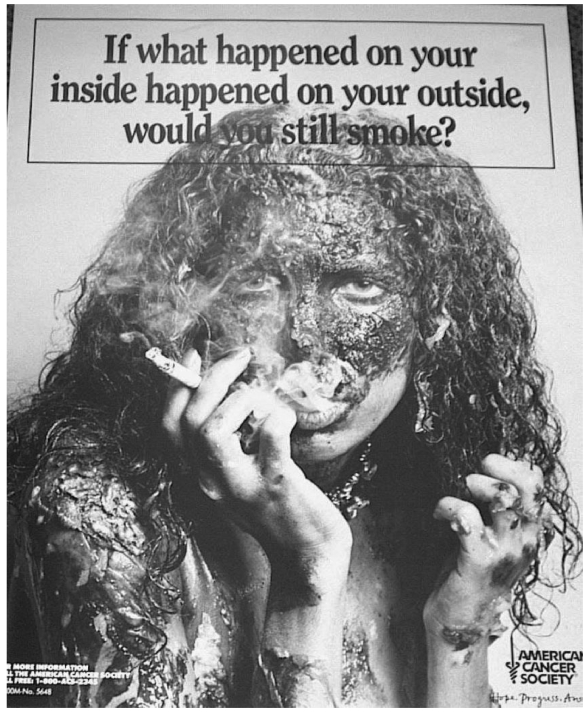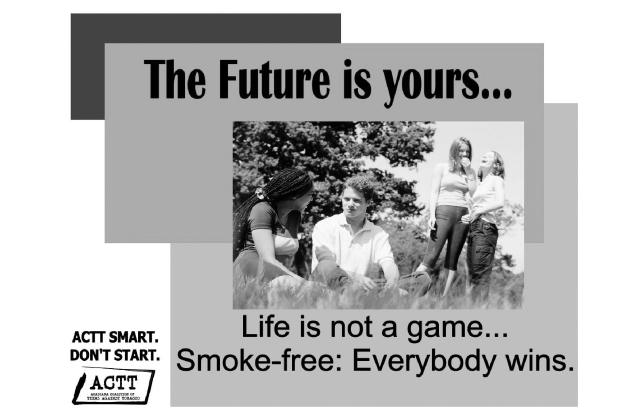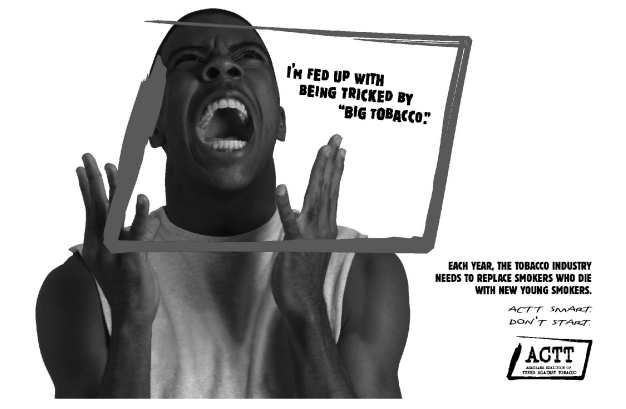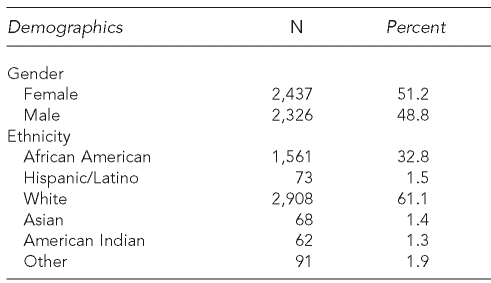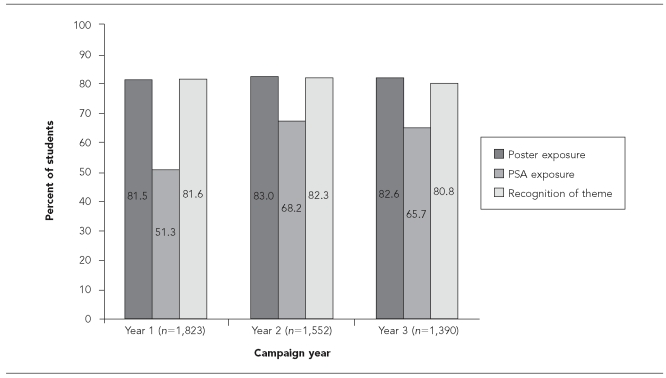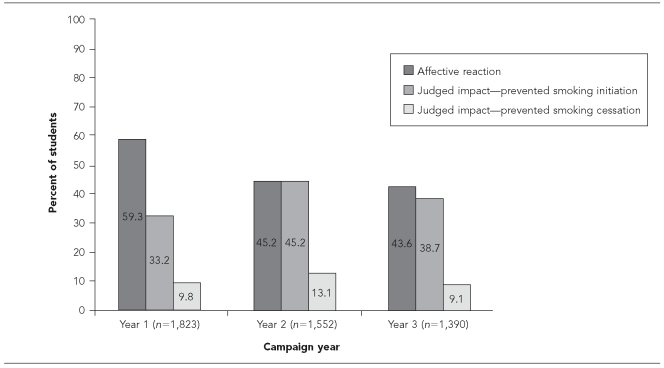SYNOPSIS
Objectives.
In light of challenges imposed by the changing media landscape and decreasing classroom time available for health interventions, new approaches are needed to disseminate anti-tobacco messages to adolescents. This study reported process evaluation of an in-school three-year anti-tobacco media campaign conducted in 10 schools in Louisiana.
Methods.
Over three years, 10 schools received an in-school anti-tobacco media campaign. The media campaign was one intervention component of the Acadiana Coalition of Teens against Tobacco. Campaign measures were tracked over the campaign's three-year duration. The campaign and evaluation were designed to target the students as they progressed through high school. The number of students who completed the surveys were 1,823 in Year 1, 1,552 in Year 2, and 1,390 in Year 3. Schools eligible for participation were publicly funded schools with no magnet or special populations and within a two-hour driving distance of the New Orleans study office.
Results.
In a self-report survey (Year 1, n=1,823; Year 2, n=1,552; Year 3, n=1,390), more than 75% and 50% of students reported being exposed to posters and public service announcements, respectively. Recognition of campaign theme was more than 80%. Almost half of respondents reported that the posters were interesting, one-third reported that the posters prevented them from smoking, and 10% reported that the posters encouraged them to cease smoking. Stock media posters had a significantly higher affective reaction than the customized media posters.
Conclusion.
Findings suggest that in-school media programs are useful and should be considered as a viable approach to health education for adolescents.
Nearly all tobacco prevention programs have a media campaign component to dissuade smoking through tailored messages designed to reach a target audience. When the target audience is adolescents, who are susceptible to smoking uptake, television is the favored media conduit because of its reach and popularity among this age group.1 However, advances in communication technologies and growing advertisement clutter pose serious barriers to the effectiveness of anti-tobacco messages disseminated using traditional mass media. In the changing media landscape, anti-tobacco media campaigns placed within schools may be particularly effective. This article reviews the challenges imposed by the changing media landscape and describes the process evaluation of a media campaign launched in a school tobacco prevention program.
To compete effectively against tobacco-related messages, anti-tobacco campaigns need a “share of voice” or similar rates of advertising exposure to attract and persuade audiences.2 However, public health-sponsored anti-tobacco campaigns are having a difficult time breaking through the advertising clutter, with tobacco company advertising matching or exceeding anti-tobacco campaigns.3 Restricted from marketing tobacco products on television, radio, and billboards, tobacco marketing is prevalent in bars,4 on the Internet,5 and at point of sale.6 In states with comprehensive tobacco-control programs, tobacco companies have increased point-of-sale marketing efforts to offset the influence of anti-tobacco campaigns.7,8 Absent from the list of outlets for advertising is schools. Anti-tobacco campaigns launched within schools can also circumvent the barriers to television advertising imposed by digital video recorders (DVRs). DVRs record television programs, which then can be viewed with the option of bypassing any or all advertisements. Nearly two-thirds of DVR users bypass all or some commercials.9 In 2007, DVRs reached about a quarter of U.S. households with a TV.10
In Louisiana public high schools, similar to other states, classroom time has been less available for health intervention programs because of teacher accountability and academic benchmark systems evaluated by standardized testing. Therefore, in the current study, an anti-tobacco media campaign was implemented within the school environment where the overall surroundings of the school—including halls and cafeteria—were used to promote tobacco prevention. Prevention programs couched within the school environment can change the broader social environment, which can influence youth behavior.11 While other health prevention programs have previously utilized the school environment approach,11–13 it does not appear that multiyear, in-school anti-tobacco media campaigns are commonly implemented. This article reports the process evaluation of an in-school media campaign for a tobacco prevention study in 10 public high schools in South Central Louisiana.
THE ACTT MEDIA CAMPAIGN
The Acadiana Coalition of Teens against Tobacco (ACTT) was a multicomponent high school-based environmental (vs. classroom) program. The purpose of ACTT was to prevent the initiation of tobacco use among adolescent nonsmokers and the crossover to regular use among adolescent experimenters. The media campaign was the only major intervention that had the potential to reach all students. Other intervention components, such as interactive educational activities implemented in hallways during recess and lunch periods, were time-limited and depended on students actively initiating participation. Thus, the rate of student exposure to these other activities was low. Media, on the other hand, were visible (posters) and audible (public service announcements [PSAs]) throughout the school with potential exposure to all students.
The ACTT campaign was guided by Social Cognitive Theory14 and social marketing principles,15,16 and was intended to deliver positive modeling and verbal and pictorial persuasion. The campaign itself was an in-school factor intended to increase awareness. The campaign messages addressed physiological and health issues related to tobacco use, Big Tobacco, and social norms and peer relationships. Social marketing principles guided the size, color, and placement of posters, as well as branding and content—an example of which was the use of teen models, considered most effective in reaching a high school student population. The coordinated campaign themes for each of the three intervention years were: “Don't be a Sucker!” (Year 1), “Say No to Big Tobacco” (Year 2), and “The Future Is Yours” (Year 3). The ACTT logo, “ACTT Smart—Don't Start,” branded all media.
Posters
For each year of the campaign, one of three types of posters varied by customization: stock media, custom low-budget media, and custom high-budget media. While posters were displayed throughout the school year, new posters were hung approximately every two months. Six stock media posters were obtained gratis from the Centers for Disease Control and Prevention (CDC) and the American Cancer Society, and some posters were purchased from tobacco prevention websites at minimal cost. Multiple copies of stock media posters were taped to school walls at specific “lifepath points” throughout the school, such as the primary entrance hall, entrances to the cafeteria and gym, and student common areas (Figure 1).
Figure 1. Stock poster from Year 1 of anti-tobacco campaign.
Three custom low-budget media posters were developed and printed in-house at Tulane University. Multiple copies of custom low-budget media posters were displayed on easels generally located at the primary entrance hallway and the student common areas. These posters were produced to feature high school-age models of varied gender and ethnicity in social settings with their peers. The theme “The Future Is Yours” was the basis of the custom low-budget media posters (Figure 2).
Figure 2. Custom low-budget poster from Year 3 of anti-tobacco campaign.
A contract with a social marketing firm produced three custom high-budget posters. These posters were 3-by-5-foot vinyl with grommets for hanging from the ceiling. Three copies of each of the three posters were hung in the schools, and 11-by-17-inch paper copies were taped to walls at strategic points, such as bathroom entrances. The custom high-budget poster featured close-up shots of high school-age models of varying gender and ethnicity who defiantly verbalized a strong stance against Big Tobacco (Figure 3).
Figure 3. Custom high-budget poster from Year 2 of anti-tobacco campaign.
PSAs
For each week that school was in session, one PSA was scheduled for weekly reading by students known for nonsmoking behavior. Students read the PSAs over the public address system in the morning before classes began and after the principal's announcement. We placed logbooks in the school to record the PSA readings. Compliance was observed to be approximately 97%. Students read the PSAs because previous research has demonstrated that peer-led involvement in school-based health prevention programs is more effective.17 Message content cycled through information transfer (e.g., “We put urea in our cigarettes; urea is found in urine, but it shouldn't bother you if you can't taste it, right?”), modeling (e.g., Boy: “Can I have a kiss?” Girl: “Not if you chew tobacco; I'm not kissing a spit-cup.” Boy and Girl: “Kissing is nicer than chewing tobacco.”), social norms (e.g., “The Real Deal is that most teens don't smoke—only 13% of you smoked in the last 30 days and 8% smoke regularly.”), economics (e.g., “The base of our business is high school students—we need to get you hooked. Sincerely, Lorrilard [we make Newports].”), and announcements (e.g., “Join the rest of the country for the Great American SmokeOut; compete with other students and teachers by pledging to stay smoke-free.”). Message delivery included rhyme, rap, conversation, and repetition.
METHODS
Design
Over three years, 10 schools received an in-school anti-tobacco media campaign. The media campaign was one intervention component of ACTT. Campaign measures were tracked over the campaign's three-year duration. Throughout the text, the campaign years will be referred to as Year 1, Year 2, and Year 3, which correspond to grades 10, 11, and 12, respectively. The campaign and evaluation were designed to target the students as they progressed through high school. The number of students who completed the surveys were 1,823 in Year 1, 1,552 in Year 2, and 1,390 in Year 3. Schools eligible for participation were publicly funded schools with no magnet or special populations and within a two-hour driving distance of the New Orleans study office. The demographic data of the schools reflect the demographic data of public schools in South Central Louisiana, where the student population is approximately 61% Caucasian, 33% African American, 1% each Latinos, Asian, and Native Americans, and 3% other.18
Process evaluation and measurement
A self-report survey adapted previously published measures1 to evaluate student exposure to the in-school media campaign related to tobacco prevention. The survey was pilot-tested prior to use. The protocol for data collection was refined after practice administrations in the pilot schools. Four measures from the survey were used in the analysis to assess the school media campaign: (1) recalled exposure to PSAs and posters, (2) recognition of campaign theme, which was different during each of the three intervention years, (3) judged impact of anti-smoking poster advertisements, and (4) affective reaction to poster advertisements. All variables in the analyses were dichotomous (yes/no) and were analyzed as the percentage of students within each school indicating a positive (yes) response to the survey items. Foils, or fake messages, were also included in the survey to permit control over inaccurate recall or socially desirable responses.
Recalled exposure to PSAs and posters was assessed by the following survey question item, “Please check all of the ACTT information/activities that you have seen or heard this semester.” Recognition of campaign theme was assessed by having students identify the theme of ACTT for the current year. Students were given a list of themes that included the foils and fictitious themes. Judged impact of antismoking poster advertisements was assessed by the following survey items: “I think that the ACTT posters helped me not to smoke” (Judged Impact—Prevented Smoking Initiation) and “I think that the ACTT posters helped me to quit smoking” (Judged Impact—Encouraged Smoking Cessation). Judged impact of antismoking advertising has been used as an indication of behavioral intentions.1 Affective reaction to the media campaign was assessed using the following survey item: “I think that ACTT posters are interesting.”
Data collection procedures
Students participated in the surveys with a passive consent in which parents signed and returned the consent form only if they did not consent to participation. Students also signed an assent form at the time of administration. In most schools, surveys were administered in classrooms; in the remainder of the schools, surveys were administered in assemblies. All data were collected by ACTT staff trained to administer the surveys. The ACTT staff consisted of researchers and research assistants from Tulane University. The ACTT staff distributed the survey questionnaire to students upon providing general instructions for filling out surveys and notifying students that the survey was anonymous. As part of the process evaluation, the ACTT staff also kept observation journals to document logistics related to the implementation of posters and PSAs in the schools. This study was approved by the Committee on Protection of Human Subjects at Tulane University.
Data analyses
Because the media campaign was one intervention component of ACTT, it is not possible to rule out the effects of the ACTT program's other tobacco prevention components. The objective of the process evaluation was to demonstrate the media campaign's reach and the student's response to the media on reported smoking behavior.
To demonstrate that the media campaign reached the target audience, we reported the proportion of students exposed to the posters and PSAs for each of the campaign years, and the percentage of students who correctly identified the campaign theme for each respective year. To demonstrate the impact of the media, we reported the proportions for three impact variables related to affective response and judged impact of antismoking poster advertisements. To determine if the campaign impact variables varied significantly across the three years, repeated measures analysis of variance was calculated. Scatter plots of media exposure variables and observation journal entries from the ACTT staff revealed that one of the media was not adequately implemented in one of the schools. Because of this outlier school, only nine of the 10 intervention schools are reported in the analysis.
RESULTS
Baseline demographics of the students who participated in the study are displayed in the Table. Figures 4 and 5 display the proportion (in percent) for the process evaluation variables reported for each campaign year. The majority of students reported being exposed to posters and PSAs throughout the three years. Exposure to posters was higher (more than three-quarters of the respondents) than exposure to PSAs, with exposure to posters higher than 80.0% for each year of the campaign. The highest media exposure occurred in Year 2, with 83.0% and 68.2% of students reporting exposure to posters and PSAs, respectively. The highest recognition of campaign theme occurred in Year 2, with 82.3% of students correctly identifying the theme, followed by Year 1 (81.6%) and Year 3 (80.8%).
Table. Baseline demographics of students exposed to the anti-tobacco media campaign (n=4,763)a.
aThe mean age was 15.4 years (standard deviation = 0.8, range = 11.8, 19.0).
Figure 4. Proportion of students reporting exposure to posters and PSAs and recognition of theme for each campaign year.
PSA = public service announcement
Figure 5. Proportion of campaign impact variables reported for each campaign year.
Among those whom the media campaign reached, many reported favorable responses to the posters. For affective response, almost half of respondents reported that the posters were interesting, with the most favorable response (59.3%) occurring in Year 1. For all three years, more than one-third of respondents reported that the posters prevented them from smoking. For all three years, approximately 10% of respondents reported that the posters encouraged them to cease smoking. The highest proportion of students—45.2% and 13.1%, respectively—who reported that the posters either prevented them from smoking or encouraged them to cease smoking occurred in Year 2.
Differences in the affective reaction and judged impact on smoking behavior for the three years were assessed based on the mean (M) and the standard deviation (SD). The results indicated that the affective reaction for the stock media year (M=59.3, SD=3.15) was significantly higher than the affective response for the custom low-budget poster (M=43.61, SD=3.28) and custom high-budget poster (M=45.17, SD=3.72), F(2,16) = 75.27, p<0.01, ηp2=0.90. For the judged impact of poster variables on smoking behavior, only prevention from smoking initiation varied significantly across the three years. The effect of posters on reported prevention of smoking in Year 2 (M=45.01, SD=4.92) was significantly higher than for Year 1 (M=33.76, SD=4.23) and Year 3 (M=38.92, SD=4.60), F(2,16) = 13.80, p<0.01, ηp2=0.63. The effect of posters on encouraging students to not smoke did not significantly vary across Year 1 (M=10.12, SD=2.13), Year 2 (M=13.60, SD=1.90), or Year 3 (M=9.28, SD=1.56), F(2,16) = 2.77, p=0.9, ηp2=0.25.
DISCUSSION
Collectively, the process evaluation suggests that a media campaign is integral and important to an in-school anti-tobacco program. The media campaign reached the majority of students, with a large percentage of students reporting favorable impact of the campaign on their smoking behavior. The highest proportion for both judged impact variables occurred in Year 2. One potential explanation for this pattern of effect is a carryover or delayed response to the media campaign. That is, the effects of the campaign in Year 1 may have occurred later and were subsequently detected during data collection in Year 2. Such delayed effect of advertisement on behavior is common.19,20 The lowest proportion of students reporting that the posters were interesting and that the posters encouraged them to cease smoking occurred in Year 3. The onset of campaign fatigue or what is commonly referred to as advertising wearout21 may have occurred in the campaign's last year. Advertising wearout pertains to an advertisement performing less effectively as repeated exposure increases.21 Previous research on antismoking campaigns has warned against campaign wearout.22,23 That the most significant effects of the media campaign occurred in the second year suggests that perhaps more attention should be paid to the campaign in the subsequent years so that the campaign's impacts can be sustained.
Another finding in this study is that stock media were associated with the most favorable responses from students. The school year with the stock posters had significantly higher affective response than the school years with custom low-budget media and custom high-budget media. It is important to note that ACTT utilized preexisting posters, which were free or of minimal cost to the prevention program. Thus, agencies that sponsored the stock poster media absorbed much of the production costs, and likely spent more on production than the in-house or commercial custom posters in the campaign of this current study. The current findings suggest that the use of preexisting well-designed stock media campaign materials may be both cost-efficient and cost-effective in eliciting desirable emotional responses among adolescents.
CONCLUSION
In summary, the findings suggest that an in-school media program is useful in tobacco prevention and should be considered as an approach to health education for students. However, further research is needed, as our results should be interpreted with some important caveats.
First, the study design does not allow conclusions to be made as to which type of poster (e.g., level of customization) elicits the most favorable affective response. Future studies may choose to have multiple intervention schools that vary in poster campaigns. In addition, differences in the campaign themes may account for the varying affective reaction. Specifically, a positive send-off message for seniors was prominent in the custom low-budget campaign year, whereas the stock media and custom high-budget campaign years contained many elements of fear appeals. While collectively the results suggest that the media campaign had an effect on smoking prevalence, it is not possible to rule out other contributing factors, including other activities initiated in the tobacco prevention program, as ACTT included other non-media tobacco-use prevention activities. Future studies should assess whether the value of stock media in eliciting favorable response is applicable beyond posters.
While we used single-item measures in the process evaluation due to time constraints imposed by school curriculum, future studies should used multi-item measurements to assess knowledge, attitudes, and behavioral intentions when possible. In addition, measurements that directly assess production quality (e.g., credibility of spokesperson) of the media should be assessed.
Footnotes
This research was supported by the Louisiana State Board of Regents, HEF (2000-05)-09, with the State Master Settlement Agreement fund. Dr. Hong was also supported by a Building Interdisciplinary Research Careers in Women's Health Scholarship (K12 HD43451) cofunded by the Office of Research on Women's Health and the Office of Dietary Supplements, National Institutes of Health.
REFERENCES
- 1.Johnston LD, Terry-McEllrath YM, O'Malley PM, Wakefield M. Trends in recall and appraisal of anti-smoking advertising among American youth: national survey results, 1997–2001. Prev Sci. 2005;6:1–19. doi: 10.1007/s11121-005-1249-6. [DOI] [PubMed] [Google Scholar]
- 2.Pechmann C. Does antismoking advertising combat underage smoking? A review of past practices and research. In: Goldberg ME, Fishbein M, Middlestadt S, editors. Social marketing: theoretical and practical perspectives. 189–216. Hillsdale (NJ): Lawrence Erlbaum Associates; 1997. [Google Scholar]
- 3.Wakefield M, Szczypka G, Terry-McElrath Y, Emery S, Flay B, Chaloupka F, et al. Mixed messages on tobacco: comparative exposure to public health, tobacco company- and pharmaceutical company-sponsored tobacco-related television campaigns in the United States, 1999–2003. Addiction. 2005;100:1875–83. doi: 10.1111/j.1360-0443.2005.01298.x. [DOI] [PubMed] [Google Scholar]
- 4.Sepe E, Ling PM, Glantz SA. Smooth moves: bar and nightclub tobacco promotions that target young adults. Am J Public Health. 2002;92:414–9. doi: 10.2105/ajph.92.3.414. [DOI] [PMC free article] [PubMed] [Google Scholar]
- 5.Hong T, Cody MJ. Presence of pro-tobacco messages on the Web. J Health Comm. 2002;7:273–307. doi: 10.1080/10810730290088148. [DOI] [PubMed] [Google Scholar]
- 6.Point-of-purchase tobacco environments and variation by store type—United States, 1999. MMWR Morb Mortal Wkly Rep. 2002;51(9):184–7. [PubMed] [Google Scholar]
- 7.Slater SJ, Chaloupka FJ, Wakefield M. State variation in retail promotions and advertising for Marlboro cigarettes. Tob Control. 2001;10:337–9. doi: 10.1136/tc.10.4.337. [DOI] [PMC free article] [PubMed] [Google Scholar]
- 8.Brown JD, Witherspoon EM. The mass media and American adolescents' health. J Adolesc Health. 2002;31(6) Suppl:153–70. doi: 10.1016/s1054-139x(02)00507-4. [DOI] [PubMed] [Google Scholar]
- 9.Mandese J. Research records high DVR penetration, commercial skipping. MediaDailyNews. 2004. Mar 1,
- 10.Reynolds M. Nielsen enters the DVR age. Multichannel News. 2006. Jan,
- 11.Flay BR. Approaches to substance use prevention utilizing school curriculum plus social environment change. Addict Behav. 2000;25:861–85. doi: 10.1016/s0306-4603(00)00130-1. [DOI] [PubMed] [Google Scholar]
- 12.Arbeit ML, Johnson CC, Mott DS, Harsha DW, Nicklas TA, Webber LS, et al. The heart smart cardiovascular school health promotion: behavior correlates of risk factor change. Prev Med. 1992;21:18–32. doi: 10.1016/0091-7435(92)90003-z. [DOI] [PubMed] [Google Scholar]
- 13.Luepker RV, Perry CL, McKinlay SM, Nader PR, Parcel GS, Stone EJ, et al. CATCH collaborative group. Outcomes of a field trial to improve children's dietary patterns and physical activity: the Child and Adolescent Trial for Cardiovascular Health. JAMA. 1996;275:768–76. doi: 10.1001/jama.1996.03530340032026. [DOI] [PubMed] [Google Scholar]
- 14.Bandura A. Social foundations of thought and action: a social cognitive theory. Englewood Cliffs (NJ): Prentice Hall; 1985. [Google Scholar]
- 15.Andreasen AR. Marketing social change: changing behavior to promote health, social development, and the environment. San Francisco: Jossey-Bass; 1995. [Google Scholar]
- 16.Kotler P, Roberto EL. Social marketing: strategies for changing public behavior. New York: Free Press; 1989. [Google Scholar]
- 17.Black DR, Tobler NS, Sciacca JP. Peer helping/involvement: an efficacious way to meet the challenge of reducing alcohol, tobacco, and other drug use among youth? J Sch Health. 1998;68:87–93. doi: 10.1111/j.1746-1561.1998.tb03488.x. [DOI] [PubMed] [Google Scholar]
- 18.Johnson CC, Myers L, Webber LS, Boris NW. Profiles of the adolescent smoker: models of tobacco use among 9th grade high school students. Acadiana Coalition of Teens against Tobacco (ACTT) Prev Med. 2004;39:551–8. doi: 10.1016/j.ypmed.2004.02.018. [DOI] [PubMed] [Google Scholar]
- 19.Clarke DG. Econometric measurement of the duration of advertising effect on sales. J Marketing Research. 1976;13:345–57. [Google Scholar]
- 20.Sawyer A, Ward S. Carry-over effects in advertising communication: evidence and hypotheses from behavioral science. Cambridge (MA): Marketing Science Institute; 1976. [Google Scholar]
- 21.Stewart DW. Advertising wearout: what and how you measure matters. J Advertising Research. 1999;39:39–42. [Google Scholar]
- 22.Pechmann C, Zhao G, Goldberg ME, Reibling ET. What to convey in antismoking advertisements for adolescents: the use of protection motivation theory to identify effective message themes. J Marketing. 2003;67:1–18. [Google Scholar]
- 23.Wakefield M, Flay B, Nichter M, Giovino G. Effects of anti-smoking advertising on youth smoking: a review. J Health Commun. 2003;8:229–47. doi: 10.1080/10810730305686. [DOI] [PubMed] [Google Scholar]



